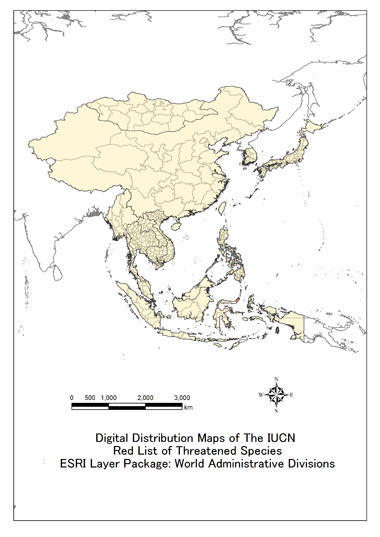
TOP > 生物多様性センターの国際協力 > ESABII > Database > Threatened Mammal Species Database > Macaca nigra

Macaca nigra
Taxonomy (Name)
| Class | MAMMALIAIUCN | |
|---|---|---|
| Order | DIPROTODONTIAIUCN | |
| Family | CERCOPITHECIDAEIUCN | |
| Scientific Name | Macaca nigraIUCN | |
| Author | (Desmarest, 1822)IUCN | |
| Synonyms | Macaca lembicus (Miller, 1931) Macaca malayanus (Desmoulins, 1824) IUCN |
|
| Common Name | Celebes Crested Macaque, Black Crested Macaque, Celebes Black Macaque, Celebes Macaque, Crested Black Macaque, Gorontalo Macaque, Sulawesi Black Macaque, Sulawesi MacaqueIUCN | |
| Local name | Brunei Darussalam | |
| Cambodia | ||
| China | ||
| Indonesia | Monyet hitam Sulawesi | |
| Japan | ||
| Lao PDR | ||
| Malaysia | ||
| Myanmar | ||
| Mongolia | ||
| Philippines | ||
| Singapore | ||
| Republic of Korea | ||
| Thailand | ||
| Vietnam | ||
Picture
Distribution, Range
This species occurs on northeastern Sulawesi, Indonesia and the adjacent islands of Pulau Manadotua and Pulau Talise. It was historically found on Pulau Lembeh as well but has probably been extirpated from there. On Sulawesi it is found on the northern arm east of the Onggak Dumoga River and Mount Padang to the tip of the peninsula (Groves 2001). There is a sizeable introduced population on Pulau Bacan in the Maluku Islands (Indonesia).
Map


Country
| Brunei Darussalam | |
|---|---|
| Cambodia | |
| China | |
| Indonesia | |
| Japan | |
| Lao PDR | |
| Malaysia | |
| Myanmar | |
| Mongolia | |
| Philippines | |
| Singapore | |
| Republic of Korea | |
| Thailand | |
| Vietnam |
Status
International Status
IUCN Red List Category
CRIUCN
Justification
This species is considered Critically Endangered in light of a continuing decline, and that in the past 3 generations (approximately 40 years) the population has been reduced by more than 80% due to habitat loss and hunting pressure. The introduced population of over 100,000 individuals is not considered in this assessment as it is a pest and is itself a threat to Bacan Island (Molucca Islands).
CITES
Appendix IIIUCN
CMS
National Status
| Country | Category | Reference |
|---|---|---|
| Brunei Darussalam | ||
| Cambodia | ||
| China | ||
| Indonesia | ||
| Japan | ||
| Korea | ||
| Lao PDR | ||
| Malaysia | ||
| Mongolia | ||
| Myanmar | ||
| Philippines | ||
| Singapore | ||
| Thailand | ||
| Vietnam |
Ecology Discription
Appearance
Habitat
This species is found in rainforests at moderate elevations.
Population size
Density is estimated to be approximately 3 individuals/km2, except in Tangkoko Batuangus where it is approximately 60 individuals/km2 (J. Supriatna pers. comm.). The introduced population on the island of Pulau Bacan in the Moluccas probably numbers at least 100,000 individuals (Rosenbaum et al. 1998), but is not considered in this assessment.
Behavior
Diet
It is frugivorous, but will also eat immature leaves, arthropods, stalks of newly flowering plants, and cultivated crops (fruits, vegetables, and maize).
Reproduction
Threat
Major Threat(s)
There is extensive habitat loss within its range. Hunting for bush meat is a major threat, so although the habitat appears to be intact in many places much of it is currently unoccupied. Some animals are also caught for the live animal trade. Extensive illegal ?small scale? open area mining for gold, using mercury, within the parks is a regional threat. Shifting cultivation by local communities is an increasing threat. This is probably the most threatened primate species on Sulawesi (J. Burton pers. comm.).
Conservation and Measurement
International
This species is listed under CITES Appendix II.IUCN
National
Conservation law
| Country | Status | Reference |
|---|---|---|
| Brunei Darussalam | ||
| Cambodia | ||
| China | ||
| Indonesia | Protected Animals ( as Cynopithecus niger) | Goverment Regulation no. 7 / 1999, about Preservation of Plants and Animals |
| Japan | ||
| Korea | ||
| Lao PDR | ||
| Malaysia | ||
| Mongolia | ||
| Myanmar | ||
| Philippines | ||
| Singapore | ||
| Thailand | ||
| Vietnam |
Protected Area
It occurs in several protected areas (Gunung Lokon, Gunung Amban,Tangkoko Batuangus, Dua Saudara, and Batu Putih). However, there is urgent action needed to stop the encroachment into protected areas especially Tangkoko, which represents the most likely viable natural remaining population of the species to survive.
Other Coservation Projects
M. nigra is relatively common in captivity.
Citation
Groves, C. P. 2001. Primate taxonomy. Smithsonian Institution Press, Washington, DC, USA.
Rosenbaum, B. O?Brien, T. G., Kinnaird, M. and Supriatna, J. 1998. Population densities of Sulawesi crested black macaques (Macaca nigra) on Bacan and Sulawesi, Indonesia: effects of habitat disturbance and hunting. American Journal of Primatology 44(2): 89-106.
Sugardjito, J., Southwick, C. H., Supriatna, J., Kohlaas, A., Baker, S., Erwin, J., Froehlich, J. and Lerche, N. 1989. Population survey of macaques in northern Sulawesi. American Journal of Primatology 18(4): 285-301.
Watanabe, K. and Matsumura, S. 1991. The borderlands and possible hybrids between three species of macaques, M. nigra, M. nigriscens, and M. hecki, in the northern peninsula of Sulawesi. Primates 32(3): 365-369.
